What a piece of work is man! How noble in reason, how infinite in faculties, in form and moving how express and admirable, in action how like an angel, in apprehension how like a god!Jean-Luc Picard, quoting William Shakespeare
Humans are such commonplace little creatures. They roam the galaxy looking for something, they know not what."
"The Human race has an enduring desire for knowledge, and for new opportunities to improve itself."
"There's certainly room for improvement, but the truth is, Data, they are a minor species in the grand scheme. Not worth your envy.Q and Data
Let me tell you something about Humans, nephew. They're a wonderful, friendly people as long as their bellies are full and their holosuites are working. But take away their creature comforts, deprive them of food, sleep, sonic showers, put their lives in jeopardy over an extended period of time, and those same friendly, intelligent, wonderful people will become as nasty and as violent as the most bloodthirsty Klingon.Quark
Humans (Homo sapiens), also known as Human beings, or occasionally Terrans, were a warp-capable humanoid species from the planet Earth, in the Sol system, Sector 001, of the Alpha Quadrant. Humans were the only surviving race of several sentient/intelligent species to have evolved from the Genus Homo. (ENT: "Dear Doctor") Humans were also one of two known spacefaring intelligent species to have originated from Earth; the other being the much older Voth, who had migrated to the Delta Quadrant 20 million years before the 24th century. (VOY: "Distant Origin")
Overview
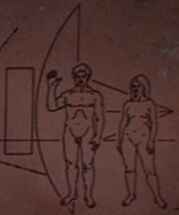
As the Latin word for their homeworld was "Terra", Humans were sometimes referred to as "Terrans", a term that was more consistently applied to Humans in the mirror universe. Occasionally, the term "Terran" was used to distinguish Humans living on Earth from those resident on colonies on other planets and moons. Some people used the adjective "Terran" to refer to subjects or institutions associated with Humanity (Terran cuisine, Terran literature, Terran art, etc.). The Borg designation for Humans was Species 5618. (VOY: "Dark Frontier")
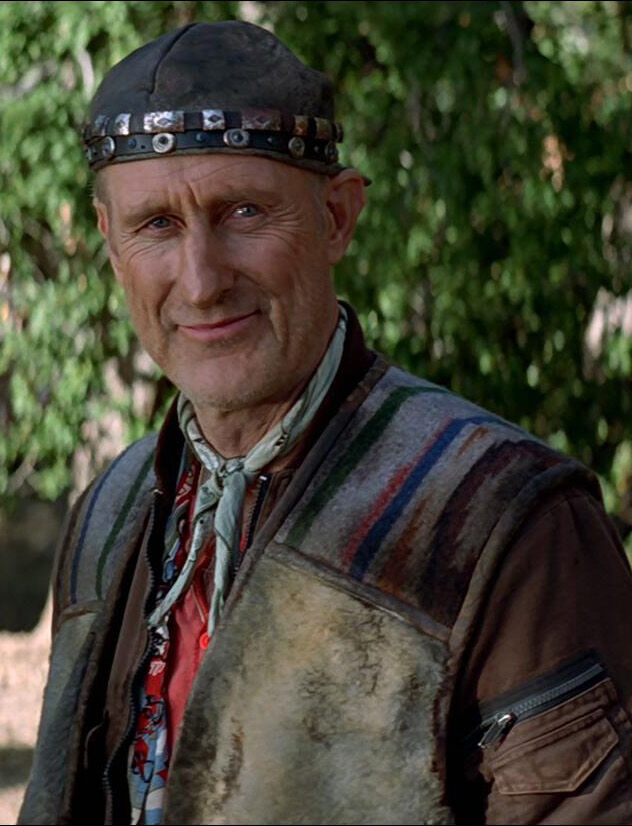
A founding member of the United Federation of Planets, Earth became warp-capable in 2063, which was the same year Humans experienced first official contact with an alien species, the Vulcans. The first warp-drive was engaged on April 5th of that year by Zefram Cochrane. (Star Trek: First Contact; ENT: "Broken Bow", "Desert Crossing", "E²"; VOY: "Year of Hell", "Relativity", "Homestead"; PIC: "Maps and Legends")
By the 24th century, Human society had changed from what it was for most of recorded history. On Earth, hunger, war, disease, famine, and poverty had largely been eliminated. The acquisition of wealth was no longer the primary driving force in the lives of many Humans. A great deal of emphasis was placed on the importance of continued social and personal development. Thanks to the non-currency-based New World Economy and the development of replicators, material needs were largely satisfied. Although money was no longer used by Humans within the Federation, they did use gold-pressed latinum and other forms of currency (such as Bajoran litas and credits) in places where it was still needed, such as Quark's. The idea behind not using money was that rather than seeking material possessions, Humans worked to better themselves and the rest of Humanity (see Human philosophy). (DS9: "Necessary Evil", "In the Cards"; Star Trek: First Contact) It must be noted that all of this more specifically applied to Humans within the Sol system, as many Earth colonies were known to have developed vast cultural differences from other Humans and some had even fallen into chaos, most notably Turkana IV. (TNG: "The Ensigns of Command", "Legacy")
Earth colonies
These colonies were established by various Earth governments or United Earth and largely remained in close contact and dependence with and on Earth. Most of them were older than the United Federation of Planets itself.
- Alpha Eridani II
- Colony Alpha 5
- Deneva colony (Deneva)
- Earth Colony II
- Lunar colonies (Luna)
- Lunar One Colony
- Orpheus Mining Complex (possibly abandoned in 2154)
- Martian colonies (Mars)
- Proxima colony (Alpha Centauri system)
- Terra Nova colony (Terra Nova, abandoned in 2083)
- Vega colony
Human settlements unaffiliated with Earth

While achieving warp capability in 2063, there were Human populations on other planets prior to this. In these cases, they would usually have been brought there by alien species, who had traveled to Earth.
In 2153, the NX-class starship Enterprise, commanded by Captain Jonathan Archer, discovered a planet in the Delphic Expanse inhabited by six thousand Humans whose ancestors had been transplanted from the Ancient West during the late nineteenth century as slave labor by the Skagarans. (ENT: "North Star")
In 2257, the Federation starship USS Discovery visited the Beta Quadrant planet Terralysium and found it to be inhabited by approximately eleven thousand Humans, descended from several hundred Earth residents who took refuge in a church in 2053, during World War III, and were rescued by the time traveler Gabrielle Burnham. Burnham used the Red angel suit to transport the people and the church to the remote Class M planet, where they established an agrarian society. The refugees were aware they were no longer on Earth, but they attributed their rescue to divinity, rather than technology; being a mixed-faith group, they devised a new religion based on seven Earth religions and also revering the Red Angel. Deeming Terralysium a pre-warp civilization subject to General Order 1, Captain Christopher Pike did not publicly reveal Discovery's presence. (DIS: "New Eden")
In 2268, the USS Enterprise discovered a population of Native Americans on the planet Amerind whose ancestors had been transplanted by an unknown alien race called the Preservers sometime in the 19th century. This population maintained their traditional lifestyle as hunters and gatherers. Captain Kirk, suffering from amnesia, was adopted into one of the tribes of Amerind under the name Kirok before recovering. (TOS: "The Paradise Syndrome")
In 2371, the USS Voyager discovered a world to which a Delta Quadrant species known as the Briori had in 1937 abducted over three hundred Humans from Earth, including aviation pioneer Amelia Earhart and her navigator Fred Noonan, whose disappearances had never been explained. The Briori utilized the Humans as slave labor until they were overthrown, and the Humans established a thriving community. Earhart, Noonan, and six other Humans had been left in a state of suspended animation. Upon being revived by the Voyager crew, Earhart and the others, who had come to be known as "the 37's" by the Human colonists, were given the option of joining the crew on their long journey back to the Alpha Quadrant. Earhart and the 37's declined and elected to remain on the planet with the other Human colonists. (VOY: "The 37's")
At least one independent Human polity was not descended from abducted Humans. The Hysperians were "Ren faire type" Humans who colonized the planet Hysperia. They were not known to be affiliated with the Federation, had their own laws, and maintained their own fleet of ships, known as the Hysperian royal navy. Furthermore, Hysperians were led by monarchs such as Queen Paolana, who was the ruler of Hysperia by 2381. (LD: "Where Pleasant Fountains Lie")
Biology
Human and Earth DNA, like much of the life in the galaxy, was originally seeded by an ancient humanoid race (which shared similar DNA), and allowed to evolve under Earth's unique conditions. In time, they became Earth's animal biota, and one line evolved into Humans over millions of years. Humans were compatible with many other humanoid races across the galaxy because of this shared DNA. (TNG: "The Chase"; VOY: "Distant Origin") Many species were also affected by the same diseases across the galaxy because of the shared DNA. Some of Humanity's evolutionary ancestors included some kind of spider, amphibians, reptiles, primates, apes, and ultimately hominid proto-Humans; each was a separate link in the Humans' evolutionary chain, stretching back to the origins of all lifeforms on Earth. (TNG: "Genesis"; VOY: "Threshold")
In TNG: "Genesis", Lieutenant Commander Data speculates that a strange contagion that has overtaken the Enterprise-D is "de-evolving" the crew, by activating introns that revert them to earlier evolutionary forms. The Humans and other "Earth"-based species in the show "devolve" into creatures ranging from arthropods (spiders, in the case of Barclay), ape-like "proto-Humans", and reptiles (Spot, Data's cat, becomes a lizard). Humans did not actually evolve from modern spiders, but the episode suggests that Humans evolved from a common ancestor between Humans and spiders, an ancestor that predates the proto-Humans. In reality, there are no known arthropods in Humanity's genetic history. (Timeline of Human evolution) It is theorized to have instead proceeded from fish, to amphibians, to reptiles, to early mammals, apes, hominids, and ancient Human species.
Similarly, in the Voyager episode "Threshold", Captain Janeway and Tom Paris evolved into salamanders similar to acanthostega (a quadruped amphibian species that is theorized to have evolved into some of the earliest lizards, and then mammals, which would later split off into apes).
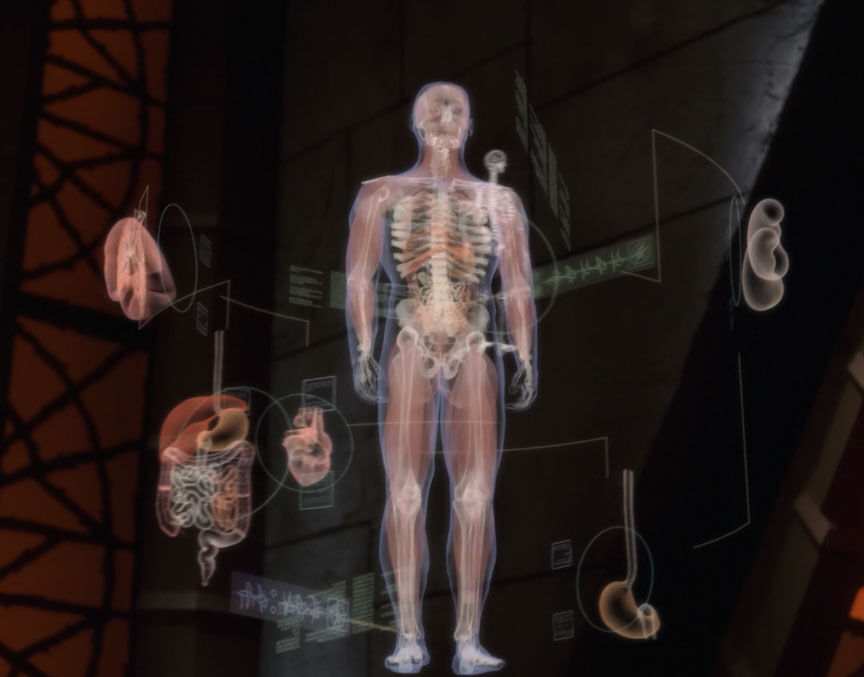
Humans evolved from australopithecines. (TNG: "Genesis") Several related species of humanoids, including Neanderthals, co-existed on Earth some thirty-five thousand years prior to the 22nd century. Evolutionary pressures led to the extinction of these other species. In the 22nd century, Humanity's closest living relative was the chimpanzee. (ENT: "Dear Doctor", "The Xindi") Bilaterally symmetrical bipedal primates, Humans were a warm-blooded humanoid species. (VOY: "Distant Origin"; ENT: "Azati Prime") They had two hands and two feet, each of which had five digits. The Human hand featured an opposable thumb and their fingers had multiple points of articulation. (VOY: "Distant Origin")
The average Human life span had gradually increased during their history largely in part to advancements in nutrition, medicine and technology improving their health and overall quality of life. At one point, it was only thirty-five years. (ENT: "Similitude") That average roughly doubled by the 20th century. During the 22nd century, it extended to about one hundred years. (ENT: "Observer Effect"). It remained largely the same through most of the 23rd century, though it wasn't unheard of for people to reach their 120s. (Star Trek) By the mid-24th century, Humans often lived to be 120 years old or more, with the oldest living Human (Leonard McCoy) living to be at least 137 years old. (TNG: "Encounter at Farpoint") By the mid-23rd century of the alternate reality, the oldest living Human was Jonathan Archer, who lived to be 145 years old. (Star Trek)
The anecdotes regarding Humans living up to 137 and 145 years are specifically attributed to Dr. Leonard McCoy and the alternate reality's Jonathan Archer, respectively. In Archer's case, he was said to be alive as of 2257. Though his full name wasn't mentioned, Star Trek co-writers Roberto Orci and Alex Kurtzman confirmed it was indeed Jonathan Archer. Even if Nero's incursion never occurred, Archer would've still turned 121 years old in 2233.
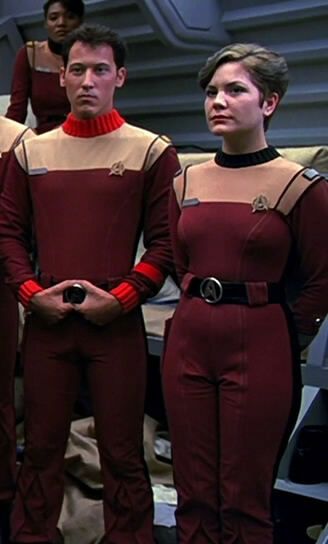
They had two sexes, as was common to many humanoid species. (ENT: "Cogenitor"; TNG: "The Outcast") The female of the species is fertile year round after she reached puberty until the onset of a biochemical stage known as menopause. (TNG: "Manhunt") Human gestation was significantly longer than the Bajoran five months. (DS9: "Body Parts") Human females can become pregnant again not long after giving birth. The make-up of Human DNA structure was significant, as, with some modifications, it allowed them to crossbreed successfully with a wide range of other races across the galaxy, including Vulcans, Betazoids, and Klingons. (TOS: "Where No Man Has Gone Before"; TNG: "Encounter at Farpoint", "The Emissary"; VOY: "Caretaker", "Faces", "Lineage")
On average, Humans were not as physically strong as some species such as Klingons and Vulcans. (ENT: "Divergence"; TOS: "This Side of Paradise"; DS9: "Take Me Out to the Holosuite") They were, however, resilient in other ways. They were more adaptable to incarceration than Klingons. (DS9: "In Purgatory's Shadow", "By Inferno's Light", "Inquisition") They could survive with one lung or kidney, despite having two of these organs initially. (Star Trek IV: The Voyage Home; VOY: "Phage", "Fury", "Lineage") Humans could also go days without water and weeks without food due to their bodies' ability to conserve water and live off stored fat. (ENT: "Strange New World", "Shuttlepod One") Their bodies' efficient temperature regulation allowed them to resist and survive cold temperatures that would adversely affect other species such as Cardassians and Klingons or high temperatures that would be uncomfortable for an Andorian. (VOY: "Displaced"; ENT: "The Aenar") Their temperature regulation in the form of sweating also provides them with remarkable endurance. It is also responsible for the "Human smell" noted by certain Vulcans. (ENT: "Broken Bow") They also possessed more acute hearing than Cardassians. (DS9: "Distant Voices")
Humans had iron-based hemoglobin in their blood. (TOS: "Obsession"; TAS: "The Pirates of Orion") Each individual's blood could be one of several blood types, which included AB-positive, O-negative, and B-negative. (ENT: "Carpenter Street"; DS9: "Broken Link", "In Purgatory's Shadow")
Humans were prone to strong, occasionally overwhelming emotions, such as love, hatred, embarrassment, and elation. (TOS: "Journey to Babel") Such feelings extended beyond sentient species. Many Humans anthropomorphized the lower lifeforms they kept as pets. Even fictional characters could elicit Human compassion. (ENT: "Dear Doctor")
Compared to other species, Humans displayed some marginal extrasensory perception; the limited evidence of abilities such as telepathy and precognition remained controversial until the 23rd century. Telepaths such as Miranda Jones were a rarity. (TOS: "Where No Man Has Gone Before", "Is There in Truth No Beauty?")
Culture
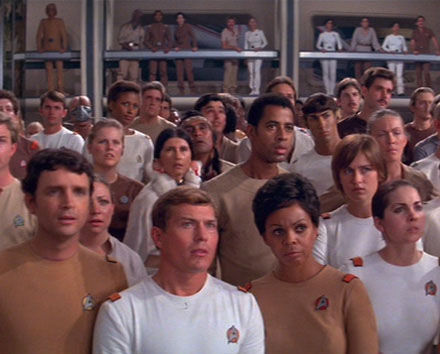
Humans were easily the most outworldly, idealistic, and expansionistic race in the United Federation of Planets, and possessed those qualities in a greater degree than many of the alien races they encountered. Humans had no true specialty or extraordinary qualities and were average in both a technological and physical sense.
The Devore inspector Kashyk remarked that Human culture had many contradictions – such as violence and beauty, as well as science and faith – all somehow mingled harmoniously, similar to the counterpoint of a musical composition. (VOY: "Counterpoint")
Because Humans were the Federation species most interested in space exploration, they made up a large majority of Starfleet. The fact that Starfleet was originally a pre-Federation Earth organization also contributed to the Human dominance of Starfleet. Humans also made up the majority of colonists on Federation colonies.
Human adaptability and their strong tradition of innovation and cooperation brought them to the forefront of the current Federation interstellar situation. It was for this very reason, however, that Human society was constantly changing and evolving. This was seen not only on the isolated colonies, where the past traditions brought by culturally and geographically homogeneous blocks of colonists competed with new cultural pragmatism demanded of frontier life, but also in the staid and settled core worlds as well. Fashion, speech, and especially political views were constantly changing.
For species that were steeped in tradition and genealogical reverence as the basis of their societies, the Human fascination with the novel experience and their unending desire to innovate and explore, to discover for the sake of discovery, were all difficult concepts to grasp.
Jazz music persisted into the 24th century and became a contribution to galactic culture, as did opera music. Humans played music collaboratively in a format known as "classical music." (TNG: "11001001", "The Ensigns of Command", "Second Chances", "Phantasms"; DS9: "The Ship"; VOY: "Virtuoso", "Renaissance Man")
Competitive sports from Human cultures also became part of Federation culture in various ways. Sports played in the 24th century included soccer (also known as "football"), fencing, and wrestling. Other Human sports included water polo, baseball, and hockey. (ENT: "Minefield"; TOS: "The Naked Time"; Star Trek; DS9: "Apocalypse Rising", "Emissary"; VOY: "Critical Care")
Humans expressed themselves through various art forms. One such art form was known as dance. (TNG: "Data's Day"; VOY: "Lifesigns")
Human cuisine had a broad spectrum, and was shared widely with other cultures. Humans were omnivorous, unlike vegetarian Vulcan culture. A small sampling of Human dishes enjoyed by other species included pecan pie and chocolate. Human foods were often connected to a place, a language, or a family, and were a part of a richer cultural experience, such as jambalaya and oden. (TOS: "All Our Yesterdays"; ENT: "Breaking the Ice"; TNG: "The Game", "Liaisons"; VOY: "Prime Factors"; DS9: "Favor the Bold") In most Human families, the woman shared in the cooking. (TNG: "Time Squared")
Human mating rituals sometimes involved a cultural ceremony known as a wedding to indicate a lasting commitment, as in other cultures, such as Vulcan and Klingon. (TNG: "Data's Day"; Star Trek Nemesis; ENT: "Breaking the Ice", "Home"; TOS: "Amok Time"; DS9: "You Are Cordially Invited", "'Til Death Do Us Part") According to divorcee Leonard McCoy in the alternate reality, "If an Earth girl says, 'It's me, not you,' it's definitely you." (Star Trek; Star Trek Beyond)
Human culture evolved to eliminate war, poverty and disease by the year 2113. (Star Trek: First Contact; ENT: "Broken Bow"; TNG: "Time's Arrow, Part II")
Humanity's children
In later centuries, Humans expanded on their desire to seek out new life by turning inward, demonstrating their abilities to create new life in their own image.
The stronger, more intelligent and physically resilient 20th century Augments may or may not have qualified as a separate species, but following his experience with Augments in the 22nd century, Dr. Arik Soong abandoned genetics for cybernetics. His work was continued and fulfilled by Dr. Noonien Soong, who created a series of sentient Soong-type androids, including Lore, B-4, Juliana Soong (the nearly perfect reproduction of his then-comatose wife), and Data (the first android to be officially ruled by Federation law as sentient, and who proved capable of reproduction by creating his own daughter, Lal). (TOS: "Space Seed"; ENT: "The Augments"; TNG: "Datalore", "The Measure Of A Man", "Inheritance"; Star Trek Nemesis)
Humans also used holographic technology to sprout new sentient life, beginning with the first self-aware holographic character, James Moriarty, in 2365. The work of Dr. Lewis Zimmerman on Emergency Medical Holograms birthed The Doctor, Humanity's most complex photonic lifeform, developed in the later 24th century. (TNG: "Elementary, Dear Data"; VOY: "Caretaker")
Alternate timelines
In an alternate timeline, Humanity was assimilated by the Borg in 2063 after the Borg prevented first contact between Humans and Vulcans. This timeline was erased when the USS Enterprise-E traveled back in time from the year 2373 to 2063 and ensured that first contact took place as history recorded it after all. (Star Trek: First Contact)
In another alternate timeline, Humanity was nearly wiped out by the Xindi in 2154, who destroyed not only Earth, but Mars, the Alpha Centauri colony, and the Vega colony, so only six thousand Humans survived. These Humans escaped to Ceti Alpha V. This alternate timeline was undone in 2165, when an experimental treatment was able to retroactively remove interspatial parasites which had nested in the brain of Captain Jonathan Archer in the year 2153; with the parasites no longer rendering him unfit for duty, Archer was able to remain in command of Enterprise, and successfully prevented the Xindi weapon from destroying Earth. (ENT: "Twilight")
As evidenced by the final draft script of ENT: "Shockwave, Part II", Humans of another alternate timeline were at one point intended to appear in that episode, living in a city which had been ruined a long time beforehand. However, in the final version of that episode, no such Humans appear.
Mirror universe
- Main article: Terran (mirror)
In the mirror universe, Humans were known as Terrans and were the founders of the Terran Empire. They were filled with fear and suspicion when a Vulcan scout ship landed on Earth to initiate first contact in 2063. The Humans slaughtered the Vulcan crew and used the technology within to create an interstellar empire. (ENT: "In a Mirror, Darkly")
This Empire lasted centuries until it was overshadowed by the equally vicious aspirations of the Klingon-Cardassian Alliance. Although many races in the mirror universe harbored hopes of forming a peaceful alliance to protect civilization, Terrans were rarely found among these rebels due to the wealth and safety afforded by their violent expansionist policies. (DS9: "Crossover")
Aliens becoming Human
Other information
- The Borg designation for Humans was "Species 5618". Humans were considered by the Borg to possess below-average cranial capacity, minimal redundant systems, and limited regenerative abilities. (VOY: "Dark Frontier")
- The Ferengi changed the pronunciation of the term Human, pronouncing it as "hew-mon". (LD: "Envoys")
- Q once stated that the Human race might one day become more powerful than the Q. (TNG: "Hide And Q")
- Occasionally, the term "Human" was used to describe races even though no link to Earth was evident, such as the Betans or the being Lazarus. (TOS: "The Alternative Factor", "The Return of the Archons")
Appendices
See also
- Miri native, a Human-looking species native to a planet closely resembling Earth.
Related topics
- Human history
- Human philosophy
- Cetacean
- Humans
- Augment
- Neanderthal
- Human recreational activities
- Human foods and beverages
- Examples of Human artists, musicians, and works of literature
Background information
Humans are the only species to have made an appearance in almost every episode to date of all twelve Star Trek series and all thirteen films. No Humans appeared in the Star Trek: Voyager episode "Living Witness" and the Star Trek: Prodigy episodes "Lost and Found", "Starstruck", "Dream Catcher", "Terror Firma", "Time Amok", "A Moral Star, Part 1", and "Ghost in the Machine", though several holographic representations of Humans are present in the aforementioned episodes. In addition, the plurality of the lead characters of every Star Trek series (with the exception of Prodigy) so far have been Human.
In the final draft and the revised final draft of the script for TOS: "The Enemy Within", Leonard McCoy submitted that part of "the Human condition" was having "an enemy within."
Apocrypha
Several non-canonical medias retcon some alien species as Humans:
- In the novel Forgotten History the planet Miri is revealed to be a version of Earth from an alternate parallel timeline that had become folded into the prime timeline due to temporal instability in the region. So the Miri natives are revealed to be Humans.
- According to the novel The Poisoned Chalice, the "Magna Romanii" are Humans transplanted from Earth by the Preservers.
- In the comic book "The Return of the Archons, Part 2" the Betans of Beta III are revealed to be the Human descendants of a lost Federation colony.
- According to The Worlds of the Federation and the novelization Star Trek 3, the Capellans are described as Humans.
- According to Star Trek Maps, it is also widely believed that Omega IV started out as a lost Human colony that had reverted to barbarism.
- Star Trek: The Next Generation Officer's Manual reveals that the Angel I natives are the descendents of a number of female leaders of the Back to Earth movement which later settled on Angel One, with the colonists becoming known as Angelites.
External links
- Human at Memory Beta, the wiki for licensed Star Trek works
- Human (Star Trek) at Wikipedia